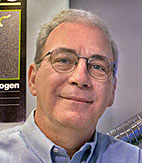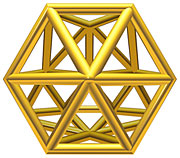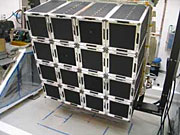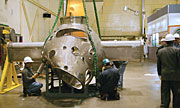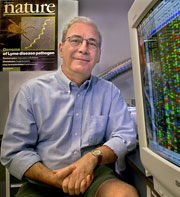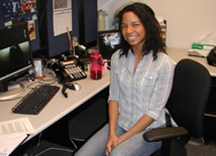| Research
|
Brookhaven Lab biologist John Dunn has been in the right place at the right time throughout the “golden age” of molecular biology, starting with his humble beginnings washing urine bottles at a hospital to earn a few bucks while in high school. There, after unknowingly washing the urine of a kidney tuberculosis patient down the drain and setting off a mild panic about a potential public health crisis, Dunn learned a lot about the TB bacterium and was hooked on microbiology. While he worked his way through West Chester State, a small teachers college in Pennsylvania, Dunn's lab experience and an influential professor led him to scuttle his initial plan to become a teacher and pursue graduate studies. “My parents were upset,” he says. “They saw teaching as a more stable career.” At Rutgers University, then at the University of Heidelberg as a postdoc, and at Brookhaven since 1972, Dunn has made a string of important contributions to the emerging field of molecular biology, including:
"The joy at Brookhaven is the ability to do, do, do and go from one thing to another,” Dunn says. Submitted by DOE's Brookhaven Lab |
|||||||||||||||||||||||||||
|
Check out the Office of Science's new Website.
|
NYC assignment reveals metropolitan bioterror mitigationIsabelle Chumfong of DOE's Sandia National Laboratories gained a new perspective during a recent unique assignment in which she spent six months working with New York City's Department of Health and Mental Hygiene (DOHMH) to develop an in-depth understanding of and contribute to the city's bioterrorism response planning and preparedness efforts.
The goal of the collaboration was to develop better strategies for collecting information about the impact of bioterror agent releases in real time for the Department of Homeland Security (DHS), which partially funded her participation, and to improve New York City's response activities. The Sandia-DOHMH team focused on improving methods and approaches for post-incident environmental air and surface sampling, which typically would be used to confirm and characterize a bioterror event. “It was really enlightening to be there,” she says, because her exposure to the real-world concerns in the public health department put into perspective some of the issues and priorities of end-users of Sandia research. The preliminary study examined the city's responsive architecture for bioterrorism events and proposed a methodology, based on modeling, for identifying promising sites for environmental sampling. These sites were chosen by analyzing an extensive set of agent release scenarios deemed most likely by New York City law enforcement and emergency management agencies. Isabelle says she appreciated learning what day-to-day questions key decisionmakers need answered, based on their goals and responsibilities. The concept of sending someone to the city agency came about early last year in a Bay Area meeting of public health, law enforcement, and environmental officials who wanted to better understand the potential hazards of bioterror releases and how to gather information about them in real time. Decisionmakers at DOHMH were eager for assistance, having heard of Sandia's initial modeling of plumes that might be generated from releases of a bioterrorism agent. Submitted by DOE's Sandia National Laboratories |
